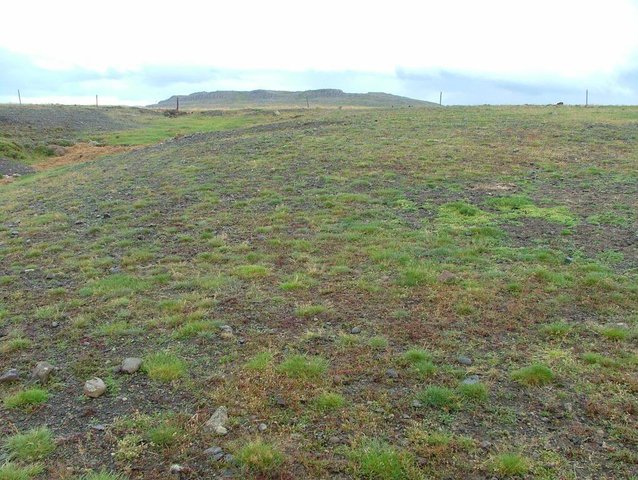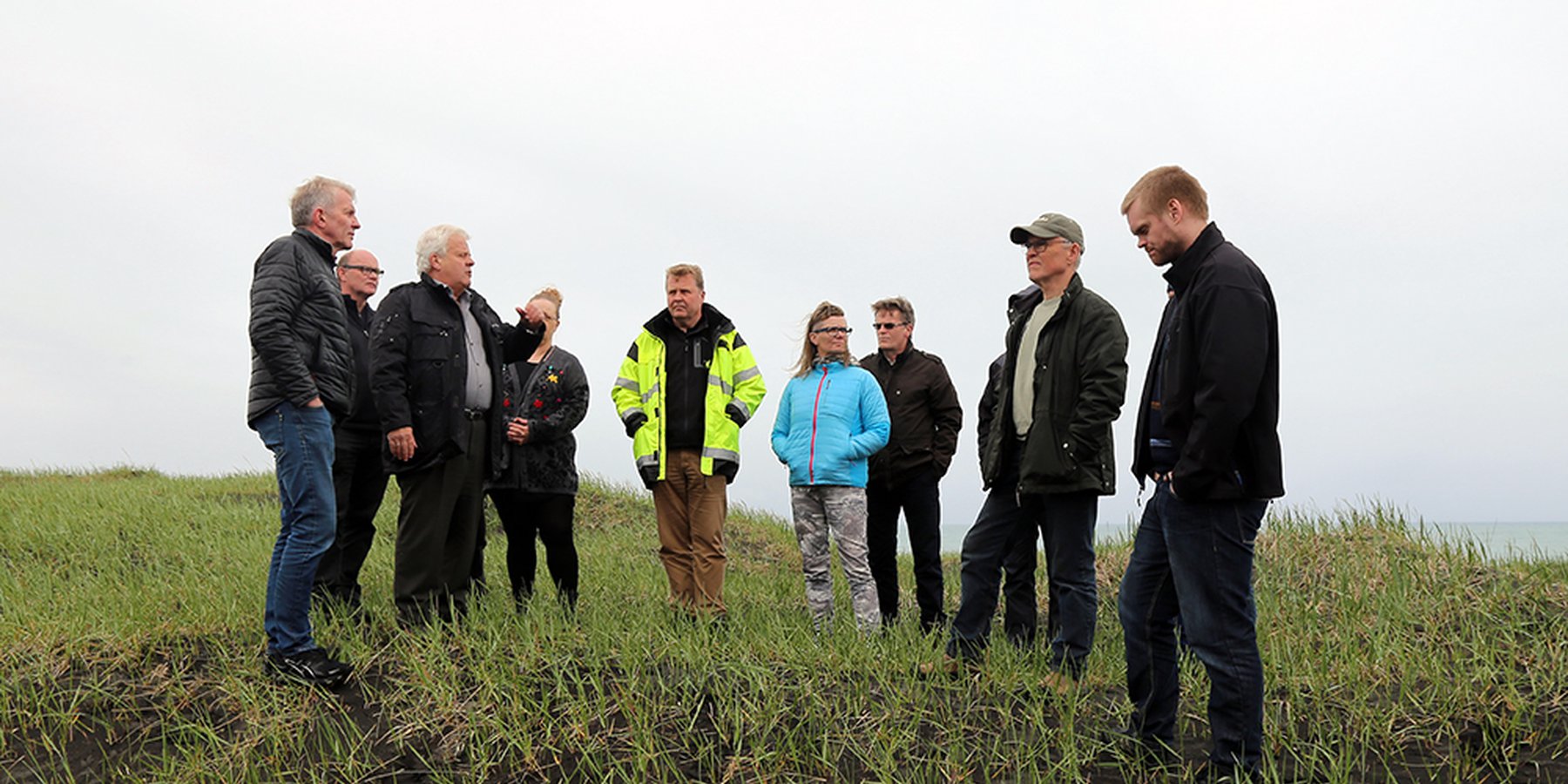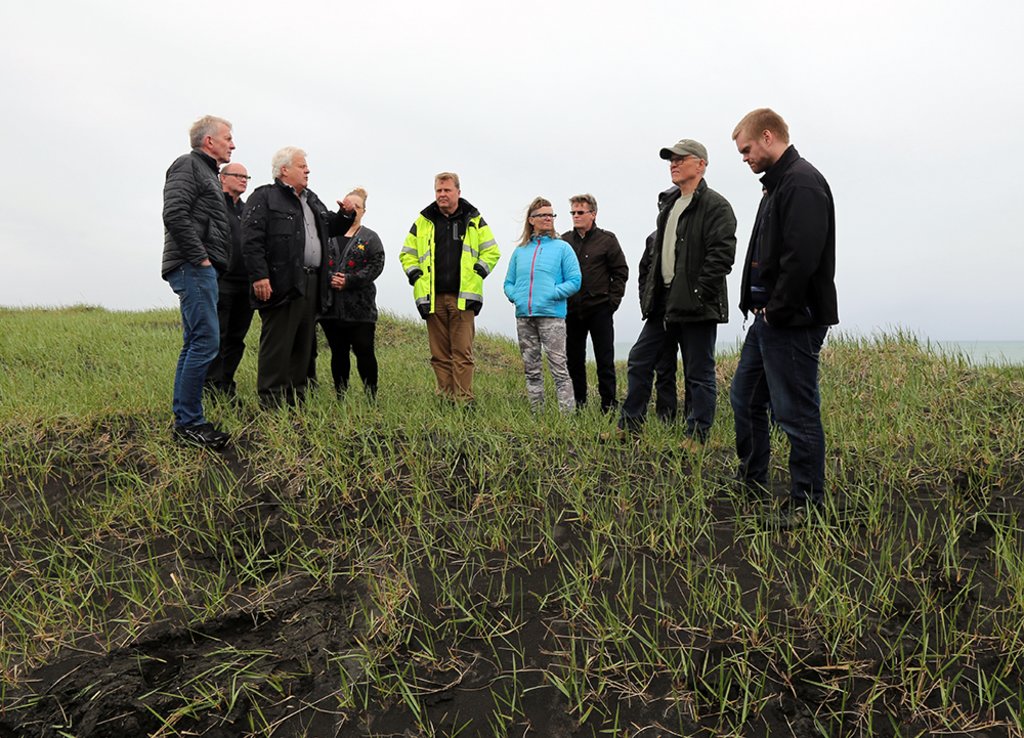Participatory cost-sharing restoration programme [Islândia]
- Criação:
- Atualização:
- Compilador/a: Thorunn Petursdottir
- Editor: –
- Revisores: Jan Reichert, Hanspeter Liniger
Farmers Heal the Land
approaches_2599 - Islândia
Veja as seções
Expandir tudo Recolher tudo1. Informação geral
1.2 Detalhes do contato das pessoas capacitadas e instituições envolvidas na avaliação e documentação da abordagem
Nome da(s) instituição(ões) que facilitou(ram) a documentação/avaliação da Abordagem (se relevante)
Soil Conservation Service of Iceland (Soil Conservation Service of Iceland) - Islândia1.3 Condições em relação ao uso da informação documentada através de WOCAT
O compilador e a(s) pessoa(s) capacitada(s) aceitam as condições relativas ao uso de dados documentados através do WOCAT:
Sim
1.4 Referência ao(s) questionário(s) sobre tecnologias da GST

Fertilizing and re-seeding degraded rangelands [Islândia]
Rangeland restoration - Spreading small portions of inorganic fertilizer and seeds on degraded rangelands
- Compilador/a: Thorunn Petursdottir
2. Descrição da abordagem de GST
2.1 Descrição curta da abordagem
Collaboration between farmers and a governmental institute on rangeland restoration and improved land management
2.2 Descrição detalhada da abordagem
Descrição detalhada da abordagem:
Aims / objectives: FHL is a governmental cost-sharing programme operated by the SCSI and run at national level. The FHL programme has been ongoing since 1990. It started as an experimental programme in Northeast Iceland, but couple of years later it was extended nationwide. It builds on voluntary participation of farmers who want to restore damaged rangelands in the lowland. The programme was established foremost to ease cooperation and strengthen social bonds between the SCSI and sheep farmers. Nevertheless, increased rangeland restoration and improved grazing management were also key targets underpinning the establishment of the FHL initiative, and formed the backbone of its prime policy.
Methods: The FHL programme is run by the Soil Conservation Service of Iceland (SCSI) and targets large-scale rangeland restoration, primarily among sheep farmers. The programme builds on voluntary approaches and uses direct and indirect incentives to motivate its participants. Farmers who want to participate apply for membership of the SCSI. The SCSI evaluates the condition of potential restoration areas and decides if they meet requirements. Each participant receives, annually, a fixed subsidy to purchase fertilizer and if needed, commercial grass seeds. Participants in the FHL project are visited approximately biannually by a regional SCSI advisor that estimates the restoration progress, discusses next steps and consults the participants on rangeland management related issues. Usually, each restoration area is treated for a couple of years before it is considered to have passed the first level of the restoration process. The restoration areas are mapped, and based on the maps participants asked to make a 3-5 year long implementation plan.
Role of stakeholders: As land stewardship plays a vital role in this programme, the role of the primary stakeholders (the farmers) is fundamental. They indeed drive the programme, although they get professional guidance and support from the extension offices of the SCSI. They are responsible for all implementation and land management on a local scale, within their own holdings.
Other important information: no further information
2.3 Fotos da abordagem
2.5 País/região/locais onde a abordagem foi aplicada
País:
Islândia
Região/Estado/Província:
Rangarthing Ytra
Especificação adicional de localização:
Rangarvellir
2.6 Datas de início e término da abordagem
Indique o ano de início:
1990
2.7 Tipo de abordagem
- Iniciativa/inovação local recente
2.8 Principais metas/objetivos da abordagem
The Approach focused mainly on SLM with other activities (rangeland restoration, sustainable land management, participatory approaches, stakeholder involvement)
To improve the ecological condition of the degraded rangelands for future generations. To facilitate behavioral changes toward more sustainable rangeland management.
The SLM Approach addressed the following problems: The main problems to be addressed by the approach were severe soil and vegetation degradation that substantially reduced biomass productivity, lack of financial support and local advisory system
2.9 Condição que propiciam ou inibem a implementação de tecnologia/tecnologias aplicada(s) segundo a abordagem
Normas e valores sociais/culturais/religiosos
- Inibitivo
Treatment through the SLM Approach:
Disponibilidade/acesso a recursos e serviços financeiros
- Inibitivo
the approach provides subsidies to participants
Treatment through the SLM Approach:
Quadro institucional
- Inibitivo
Establishment of extension offices that provide advisory service on restoration and SLM technologies and approaches, free of charge to all land users.
Treatment through the SLM Approach:
Quadro jurídico (posse de terra, direitos de uso da terra e da água)
- Inibitivo
Treatment through the SLM Approach:
Conhecimento sobre GST, acesso a suporte técnico
- Inibitivo
Establishment of extension offices that provide advisory service on restoration and SLM technologies and approaches, free of charge to all land users.
Treatment through the SLM Approach:
Carga de trabalho, disponibilidade de força de trabalho
- Inibitivo
Treatment through the SLM Approach:
3. Participação e papel das partes interessadas envolvidas
3.1 Partes interessadas envolvidas na abordagem e seus papéis
- Usuários de terra/comunidades locais
Main actors - voluntary work, mostly at their own expenses
- Especialistas em GST/ consultor agrícola
- Governo local
Provide small scale funding
- Governo nacional (planejadores, responsáveis pelas decisões)
Main funding contributor - advisory system - local support
- Organização internacional
3.2 Envolvimento do usuários de terra/comunidades locais nas diferentes fases da abordagem
| Envolvimento do usuários de terra/comunidades locais | Especifique quem estava envolvido e descreva as atividades | |
|---|---|---|
| Iniciação/motivação | Automobilização | |
| Planejamento | Participativo | |
| Implementação | Automobilização | |
| Monitoramento/avaliação | Passivo | |
| Research | Nenhum |
3.4 Decisão sobre a seleção de tecnologia/tecnologias de GST
Especifique quem decidiu sobre a seleção de tecnologia/tecnologias a serem implementadas:
- Principalmente especialistas em GST, após consulta com usuários da terra
Explique:
Decisions on the method of implementing the SLM Technology were made by mainly by land users supported by SLM specialists
4. Suporte técnico, reforço das capacidades e gestão do conhecimento
4.1 Reforço das capacidades/formação
Foi oferecida formação aos usuários da terra/outras partes interessadas?
Sim
Especifique quem foi capacitado:
- Usuários de terra
- Equipe de campo/consultores
- Researchers
Tipo de formação:
- Em exercício
- Agricultor para agricultor
- Áreas de demonstração
- Reuniões públicas
- Cursos
Tipo de formação:
- local advisors that visit/contact all participants
Assuntos abordados:
E.g. the role of ecosystem services for human well-being, ecosystem resilience and natural hazards, the importance of proper grazing management and the importance of merging local and external knowledge to secure more effective long-term social-ecological progress.
4.2 Serviço de consultoria
Os usuários de terra têm acesso a um serviço de consultoria?
Sim
Descreva/comentários:
Advisory service is very adequate to ensure the continuation of land conservation activities
4.4 Monitoramento e avaliação
Monitoramento e avaliação são partes da abordagem?
Sim
Comentários:
bio-physical aspects were regular monitored by project staff through observations; indicators: visual estimation
bio-physical aspects were ad hoc monitored by other through measurements; indicators: Researchers of the SCSI
technical aspects were ad hoc monitored by project staff through observations; indicators: Researchers in collaboration with the SCSI
socio-cultural aspects were ad hoc monitored by other through measurements; indicators: Researchers in collaboration with the SCSI
economic / production aspects were ad hoc monitored by other through observations
area treated aspects were monitored by project staff through observations
There were no changes in the Approach as a result of monitoring and evaluation
There were few changes in the Technology as a result of monitoring and evaluation: Reduced amount of fertilizer and seed when restoration areas are treated
4.5 Pesquisa
A pesquisa foi parte da abordagem?
Sim
Especifique os tópicos:
- Sociologia
- Ecologia
Dê mais detalhes e indique quem realizou a pesquisa:
Research was carried out both on station and on-farm
5. Financiamento e apoio material externo
5.1 Orçamento anual para o componente de GST da abordagem
Caso o orçamento exato seja desconhecido, indique a faixa:
- 100.000-1.000.000
Comentários (p. ex. principais fontes de recursos/principais doadores):
Approach costs were met by the following donors: government: 78.0%; local government (district, county, municipality, village etc): 2.0%; local community / land user(s): 20.0%
5.2 Apoio financeiro/material concedido aos usuários da terra
Os usuários da terra receberam apoio financeiro/material para a implementação de tecnologia/tecnologias?
Sim
5.3 Subsídios para entradas específicas (incluindo mão-de-obra)
- Agrícola
| Especifique quais entradas foram subsidiadas | Em que medida | Especifique os subsídios |
|---|---|---|
| Fertilizantes | Parcialmente financiado | Up to 85% of the cost of the fertilizer |
Se a mão-de-obra pelos usuários da terra foi uma entrada substancial, isso foi:
- Voluntário
Comentários:
Voluntary but also subsidies for purchasing inorganic fertilizer
6. Análise de impactos e declarações finais
6.1 Impactos da abordagem
A abordagem auxiliou os usuários da terra a implementar e manter as tecnologias de GST?
- Não
- Sim, pouco
- Sim, moderadamente
- Sim, significativamente
Did other land users / projects adopt the Approach?
- Não
- Sim, pouco
- Sim, moderadamente
- Sim, significativamente
Did the Approach lead to improved livelihoods / human well-being?
- Não
- Sim, pouco
- Sim, moderadamente
- Sim, significativamente
6.2 Principal motivação dos usuários da terra para implementar a GST
- Produção aumentada
- Lucro (lucrabilidade) aumentado, melhora da relação custo-benefício
- Pagamentos/subsídios
- normas e regulamentos (multas)/aplicação
- Prestígio, pressão social/coesão social
- Afiliação a movimento/projeto/grupo/rede
- Consciência ambiental
- Melhoria estética
- well-being and livelihoods improvement
6.3 Atividades de sustentabilidade de abordagem
Os usuários da terra podem manter o que foi implementado através da abordagem (sem apoio externo)?
- Sim
6.4 Pontos fortes/vantagens da abordagem
| Pontos fortes/vantagens/oportunidades na visão do compilador ou de outra pessoa capacitada |
|---|
| Builds up trust between farmers and governmental officials. Awareness raising and can facilitate discussions on improved rangeland management |
6.5 Pontos fracos, desvantagens da tecnologia e formas de superá-los
| Pontos fracos/vantagens/riscos na visão do compilador ou de outra pessoa capacitada | Como eles podem ser superados? |
|---|---|
| governement pays the most | awareness rising farmers to restore the land |
| government has to trust that the farmer is doing the job | checking in the field (but number of used material difficult to count afterwards und the right time in the spring) |
7. Referências e links
7.1 Métodos/fontes de informação
- visitas de campo, pesquisas de campo
- entrevistas com usuários de terras
Links e módulos
Expandir tudo Recolher tudoLinks

Fertilizing and re-seeding degraded rangelands [Islândia]
Rangeland restoration - Spreading small portions of inorganic fertilizer and seeds on degraded rangelands
- Compilador/a: Thorunn Petursdottir
Módulos
Não há módulos



